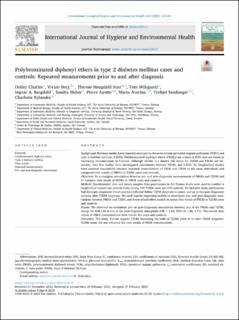| dc.contributor.author | Charles, Dolley | |
| dc.contributor.author | Berg, Vivian | |
| dc.contributor.author | Nøst, Therese Haugdahl | |
| dc.contributor.author | Wilsgaard, Tom | |
| dc.contributor.author | Bergdahl, Ingvar A. | |
| dc.contributor.author | Huber, Sandra | |
| dc.contributor.author | Ayotte, Pierre | |
| dc.contributor.author | Averina, Maria | |
| dc.contributor.author | Sandanger, Torkjel M | |
| dc.contributor.author | Rylander, Karin Charlotta Maria | |
| dc.date.accessioned | 2023-04-12T07:41:34Z | |
| dc.date.available | 2023-04-12T07:41:34Z | |
| dc.date.created | 2023-03-27T14:24:13Z | |
| dc.date.issued | 2023 | |
| dc.identifier.citation | International Journal of Hygiene and Environmental Health. 2023, 249 . | en_US |
| dc.identifier.issn | 1438-4639 | |
| dc.identifier.uri | https://hdl.handle.net/11250/3062515 | |
| dc.description.abstract | Background
Previous studies have reported associations between certain persistent organic pollutants (POPs) and type 2 diabetes mellitus (T2DM). Polybrominated diphenyl ethers (PBDEs) are a class of POPs that are found in increasing concentrations in humans. Although obesity is a known risk factor for T2DM and PBDEs are fat-soluble, very few studies have investigated associations between PBDEs and T2DM. No longitudinal studies have assessed associations between repeated measurements of PBDE and T2DM in the same individuals and compared time trends of PBDEs in T2DM cases and controls.
Objectives
To investigate associations between pre- and post-diagnostic measurements of PBDEs and T2DM and to compare time trends of PBDEs in T2DM cases and controls.
Methods
Questionnaire data and serum samples from participants in the Tromsø Study were used to conduct a longitudinal nested case-control study among 116 T2DM cases and 139 controls. All included study participants had three pre-diagnostic blood samples (collected before T2DM diagnosis in cases), and up to two post-diagnostic samples after T2DM diagnosis. We used logistic regression models to investigate pre- and post-diagnostic associations between PBDEs and T2DM, and linear mixed-effect models to assess time trends of PBDEs in T2DM cases and controls.
Results
We observed no substantial pre- or post-diagnostic associations between any of the PBDEs and T2DM, except for BDE-154 at one of the post-diagnostic time-points (OR = 1.65, 95% CI: 1.00, 2.71). The overall time trends of PBDE concentrations were similar for cases and controls.
Discussion
The study did not support PBDEs increasing the odds of T2DM, prior to or after T2DM diagnosis. T2DM status did not influence the time trends of PBDE concentrations. | en_US |
| dc.language.iso | eng | en_US |
| dc.publisher | Elsevier B. V. | en_US |
| dc.rights | Navngivelse 4.0 Internasjonal | * |
| dc.rights.uri | http://creativecommons.org/licenses/by/4.0/deed.no | * |
| dc.title | Polybrominated diphenyl ethers in type 2 diabetes mellitus cases and controls: Repeated measurements prior to and after diagnosis | en_US |
| dc.title.alternative | Polybrominated diphenyl ethers in type 2 diabetes mellitus cases and controls: Repeated measurements prior to and after diagnosis | en_US |
| dc.type | Peer reviewed | en_US |
| dc.type | Journal article | en_US |
| dc.description.version | publishedVersion | en_US |
| dc.source.volume | 249 | en_US |
| dc.source.journal | International Journal of Hygiene and Environmental Health | en_US |
| dc.identifier.doi | 10.1016/j.ijheh.2023.114148 | |
| dc.identifier.cristin | 2137261 | |
| dc.source.articlenumber | 114148 | en_US |
| cristin.ispublished | true | |
| cristin.fulltext | original | |
| cristin.qualitycode | 2 | |

